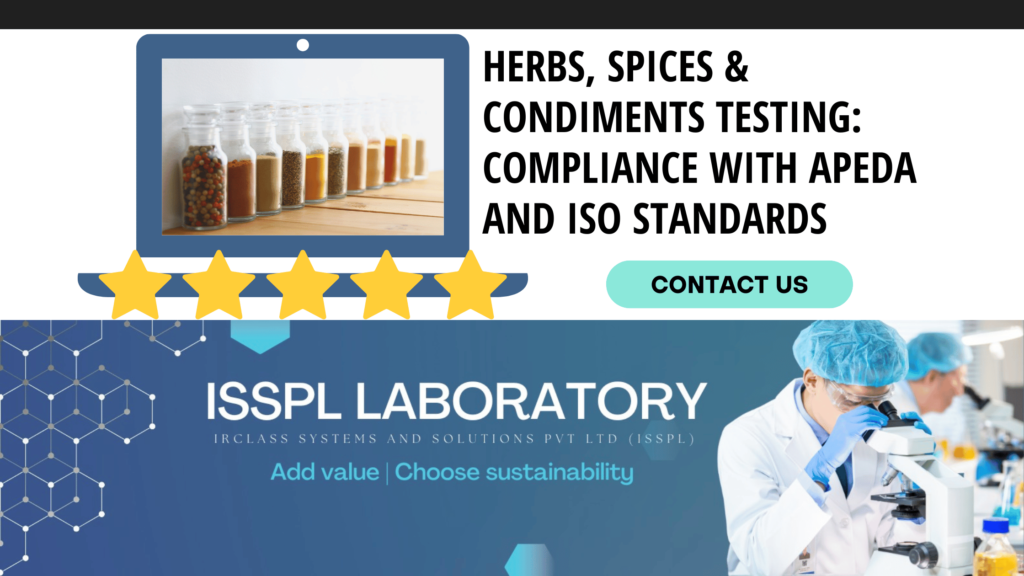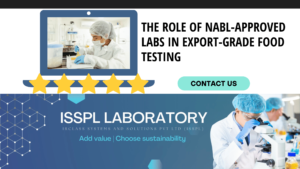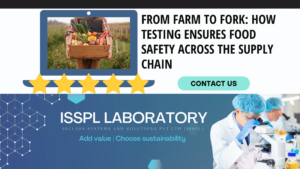An Overview by Team ISSPL - Analytical Testing Laboratory in India
ToggleHerbs, spices and condiments are used every day across homes, restaurants and food industries. They add flavor, color and shelf life. They also affect trade. Shipments may be stopped due to quality issues or safety concerns. That is why testing matters.
Every exporter or processor that deals with these items needs to meet set standards. These standards come from bodies like APEDA and ISO. Meeting them is not a choice. It is a requirement for market access and customer trust.
What Makes These Products So Sensitive
Herbs, spices and condiments come from farms. They pass through storage, drying and packaging before they reach the market. Each step carries a risk.
Moisture, bacteria, dust and chemical residues can get in. Poor storage can lead to mold. Even the drying process can introduce toxins. These are hard to spot with the naked eye. The only way to detect them is through lab testing.
Many of these products are used raw or with minimal cooking. That makes safety even more important. Any leftover pesticide or bacterial presence can enter the body.
APEDA and ISO standards were created to prevent that. Their rules cover what levels are allowed and how testing must be done.
What APEDA Requires
APEDA stands for Agricultural and Processed Food Products Export Development Authority. It works under the Ministry of Commerce in India.
For herbs, spices and condiments, APEDA has set rules that guide how products should be grown, stored and tested. These rules apply to anyone who wants to export.
Tests are done for:
- Pesticide residue beyond allowed limits
- Microbial load, such as Salmonella or E. coli
- Mycotoxins from fungal growth
- Heavy metals like lead or arsenic
- Artificial colours or unauthorised additives
These are tested in certified labs. Results must be recorded. Only those products that pass all tests are cleared for export.
APEDA standards are strict because importing countries like the EU, US or Japan follow high safety norms. One failure can lead to rejection of an entire shipment. Repeat issues can lead to bans.
How ISO Standards Fit In
ISO stands for International Organisation for Standardisation. It sets rules that labs must follow to maintain quality. For food testing, ISO 17025 is the key standard.
This standard does not talk about food limits. It talks about how labs should work. It checks how samples are collected along with how instruments are calibrated and how reports are written.
When a lab is ISO 17025 certified, it shows that the results can be trusted. It means that the process is correct from start to end.
For a food exporter, this matters. If the lab is not certified, the report may not be accepted by buyers or customs officers. It becomes a weak link in the supply chain.

Why Testing Needs to Happen at Every Stage
Many exporters wait until the last stage to do testing. That leads to losses. If a batch fails after packing, it cannot be sold. Delays follow, and costs increase.
Instead, testing should start at the farm level. If herbs or spices are grown with banned pesticides, they will not pass later. Soil and water can also be tested to find problems early.
Next comes the storage stage. This is where moisture levels need to be controlled. Fungal growth often starts here. Testing can detect aflatoxins that are dangerous to health.
The final stage is packing. Here is where hygiene comes in, bacteria or foreign matter should be checked in packing areas. Even printed labels may contaminate the product despite the use of ink that is not safe.
The last-minute surprises are avoided by the step-by-step testing. It also builds a clean track record. That helps in business in the long run.
What Labs Actually Do
Labs that test herbs, spices and condiments follow clear procedures. They collect samples using safe methods. These samples are not exposed to air or moisture. They are stored in clean containers and moved to the lab without delay.
The tests may take a few hours or a few days, based on what is being checked.
Moisture levels are tested using ovens or moisture analysers. Pesticides are detected using advanced machines like GC-MS or LC-MS. Microbial presence is found using culture plates. Mycotoxins are found using ELISA kits or chromatography.
All of this needs trained people. It also requires quality equipment and a clean working space.
Once the results are ready, a report is made. This report clearly says what was tested and what was found. It compares the findings with the allowed limits under APEDA and ISO rules.
What Happens if a Batch Fails
Sometimes a product does not meet the standards. Maybe the pesticide level is too high. Maybe the color used is not allowed.
In this case, the exporter has two choices. They can reprocess and retest or discard the batch.
Reprocessing means cleaning or heat-treating the product again. But it does not always work. Some chemical issues cannot be fixed.
That is why it is better to catch the issue early through regular testing. It costs less and saves time.
Why Testing Supports Market Access
Buyers do not just want samples. They want proof that the whole batch is safe. When test reports from a trusted lab are attached, the order moves faster.
Ports and customs offices also ask for these reports. If a lab is certified and known, the paperwork clears faster. That leads to fewer delays and lower holding charges.
Testing also supports traceability. If there is ever a recall or query, the exporter can show that all steps were followed. That protects the brand name.
What Makes a Lab Right for the Job
Not every lab is ready to test herbs, spices and condiments. The lab must have the right tools. It must follow clean sample handling. It must give clear and timely reports.
Look for labs that are ISO 17025 accredited. Check if they have experience in food testing. Also check if they are approved by APEDA or similar bodies.
The lab team should be able to explain results in simple words. They should not just send numbers. They should help you understand what action is needed if there is a problem.
Some labs also offer pickup service or remote sample booking. That helps when the units are far from city centres.
Why This is a Growing Need
India exports a wide range of herbs along with spices and blended seasonings. These include turmeric, cumin, fennel, cinnamon, black pepper, dried ginger, garlic powder and curry mixes.
With growing demand from Europe, the Middle East, and Southeast Asia, quality testing is now the primary gatekeeper.
Traders who do not invest in testing are left behind. Their shipments face delays or returns. Their customer trust takes a hit.
Those who test regularly stay ahead. They move faster. They build long-term business links.
The Role of ISSPL
ISSPL laboratory supports this entire process. Their team works across food and agriculture testing with deep experience in herbs, spices and condiments. The main lab in Jaipur is ISO 17025 accredited and also approved by FSSAI and EIC. They help exporters meet APEDA standards and clear shipments with confidence, for more, visit isspllab.com.
FAQs
Why should herbs, spices and condiments be tested before export?
These products often carry risks like pesticide residue or microbial growth. Since many of them are consumed without full cooking, any safety issue can lead to serious health problems. Testing confirms that they meet the required limits before they reach the buyer.
What kind of tests are needed to meet APEDA standards?
Tests are done for pesticide residue along with heavy metals, mycotoxins, banned colors and microbial presence. These tests must be done in certified labs using approved methods.
When is the best time to do the testing?
Testing should be done in stages. That includes raw material, storage, processing and final packaging. This helps catch issues early and avoid losses at the end.
Do buyers accept all test reports?
No. Buyers and customs offices accept reports only from certified labs. Labs must follow ISO 17025 and also be approved by regulatory bodies. This ensures the results are accurate and reliable.
What happens if the product fails a test?
If a batch fails, it may be reprocessed or discarded. Reprocessing can work for some microbial or moisture issues. But chemical contamination or excess pesticide levels are harder to fix. Early testing helps avoid this risk.







